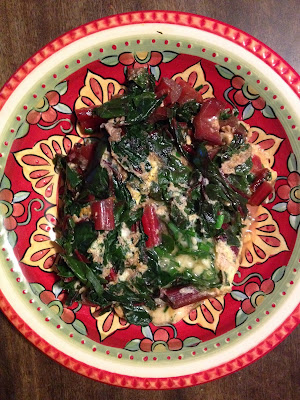If you’ve ever perused the vegetable section of the awesome
Monash University FODMAP app and wondered what the hell “Silver Beet” is,
here’s your answer:
Swiss Chard.
I don’t know why they call it Silver Beet down under and
Swiss Chard up top but beets and chard are
in the same family and the stem of the classic Swiss Chard is white, which is kind of silvery compared to red, the stem color of
beet greens.
However, modern Swiss Chard appears not only in classic white stem, but also in a panoply
of Rainbow Chard colors—orange, pink, yellow and even a deep, beety red. So “Silver”
Beet is somewhat of a misnomer, imho.
Anyhoo, Swiss Chard (plain old “chard” for short) is extremely low in FODMAPs, fully
green-lighted in the Monash app and one of THE safest
vegetables you can eat when you have SIBO (provided you don't also have kidney stones*, which hopefully you don't because ouch, and SIBO is bad enough.) Peak season runs all summer long so
it’s definitely worth getting to know this veggie now in case you don’t already.
Chard is not only delicious but also super high in vitamins
and minerals. According to
WHfoods.com, it ranks second only to spinach,
another cousin, in overall nutrient bang for your buck. (Chard, beets and
spinach are all related to quinoa, too—what a healthy family!)
Chard is packed wth phytonutrients including
detox-supportive betalains, cardio-protective kaempferol and blood-sugar
regulating syringic acid, along with at least 10 other identified antioxidant
polyphenols that double as anti-inflammatory compounds. Anti-inflammatory means
gut-healing. SIBO + chard = a match made in heaven.
Chard leaves only take about 3 minutes to cook and are a bit
less tender and fragile than spinach leaves, meaning chard exhibits much less shrinkage than spinach
in response to heat. The stems are even sturdier, resembling a thin, flat celery stalk. Being more fibrous than the leaves, chard stems take longer to cook. To account for
this fact, I usually dice up the stems and cook ‘em first for a minute or two
before adding leaves to pot or pan.
Chard is coming into season this month so I’ve been eating it pretty
much daily, in different guises. Here are three methods I like for preparing and
enjoying the incredible Silver Beet, aka Swiss Chard.
1. Braised Chard (served here with "Classic Brined" Rotisserie
Chicken)
In this first recipe, I simply simmered some chard in
about an inch of homemade chicken broth. (Braising's just another word for cooking things in broth.) To try this at home, dice chard stems and cook for
2-3 minutes in simmering broth, then add chopped leaves, cover pot and simmer on low until wilted, another
minute or two. Easy!
After a long day at work, this quick and easy side dish added
some fresh love to my pick-up meal, provided courtesy of Whole Foods Market where both the Plain and Classic Brined rotisserie chickens are made with
SIBO-safe seasonings.
2. Sautéeed Chard (accompanied here by Pan-Fried
Salmon with Dill)
In this flash-of-genius one-pan recipe, I saved myself some clean-up time by cooking salmon
first in a medium sized cast-iron pan. When fish was done, I set it aside and cooked the chard right in
the same pan over medium heat!
As always, cook diced stems first until they begin to
soften, then add the leaves. I also tossed in a handful of fresh chopped dill and let that cook in for the last minute.
To make salmon taste great, I start
it off skin side down and pour some wheat-free tamari on the top, which causes a sizzle. Cook fish for first 5
minutes skin side down, then flip and brown the other side until done, another 5-8 minutes. Flip back to skin side down if more cooking time is required.
3. Scrambled Chard with Cheesy Eggs and fresh Chives

This was fun—kind of an easy “faux soufflé” or chard
pancake. I admit it doesn't look too beautiful, but looks can be deceiving.
To make this dish, just fry up some chard in a little butter, diced stems first
(you knew I was going to say that!)
for a couple minutes, followed by chopped leaves. When leaves have turned bright green, add 2 beaten eggs per person to the pan. (I beat mine with a dash of wheat-free tamari or
Bragg’s Liquid Aminos—very tasty.)
Let eggs set for a minute, then flip, fold
or scramble. When eggs look nearly done but are still slightly wet, add a
tablespoon or two of grated hard cheese and some fresh chives if you have ‘em.
(If not, use dried herbs of choice. Tarragon is GREAT with eggs, as is dill.)
Wait until the cheese melts (you might do a final fold here), then plate and
serve!
*Note: The only potential downside to chard is that it
contains fairly high levels of oxalic acid, a compound that can bind to
calcium, blocking its absorption. Calcium-oxalate stones may form in the kidneys of people who
are sensitive to oxalic acid but it is not clear if dietary oxalate is a major
cause of oxalate stones, and
many foods contain it—not just chard, but also
spinach, beets and quinoa (surprise!), rhubarb, berries and a bunch of others. While consuming oxalic acid-rich foods is
not generally recommended for people with kidney or gallstone problems,
research suggests that the amount of protein, calcium, and water you consume
may influence calcium oxalate stone formation as much as, if not more than,
dietary oxalate intake. This is good news for SIBO peeps who rely on animal protein as their #1 safe food, and hopefully are
hydrating regularly. Cooking reduces the amount of oxalic acid in foods.





